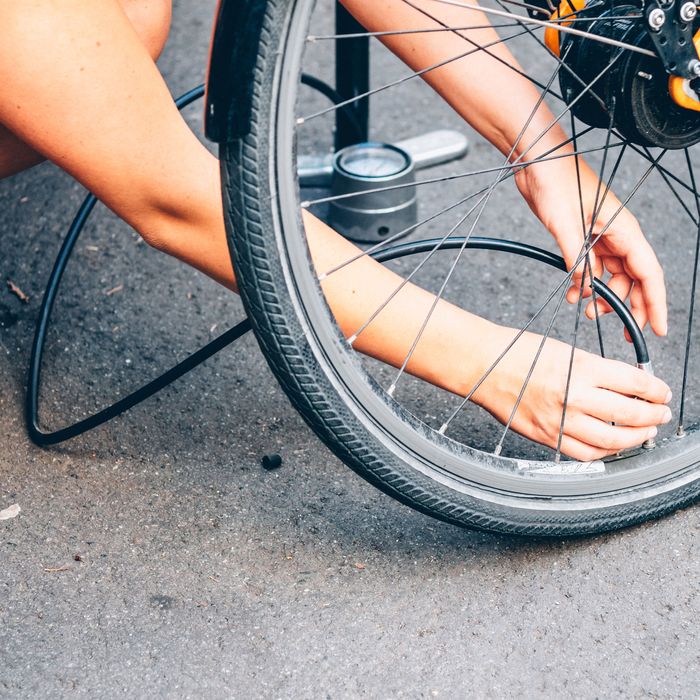There are so many DIY ideas circulating the internet. Maybe you recently saw that your tires were looking a little low and you were looking for a way to fix that. If you surveyed your garage and found a bike pump, I have some good news for you: it might be able to inflate your car tire.
Yes, you can use a bike pump to inflate a car tire, but it’s going to take a long time. Manually pumping a tire can take upwards of 20 minutes depending on how flat the tire is. Whenever possible, I would highly suggest using a compressor to pump up your car tire instead. Regardless, a bike pump will work if you’re in a pinch.
In this guide, I’ll talk a little bit about tires and tire pressure. From there, I’ll explain how a bike pump might help you, and I’ll give you a step-by-step guide to use one to inflate your tire.
Within your tire, there is ‘air’ that inflates the rubber. A modern tire contains this air with the tire’s beads, inner liner, and bead filler.
There’s a little passageway for air to travel through on the side of your tire, called the valve stem. The way this valve is designed is that it allows air to enter but doesn’t allow air to exit.
As a result, you’re left with pressurized air inside. This is because the air just keeps funneling in when you pump it in and there’s no place for it to escape. It’s the same reason why a balloon expands when you blow into it.
You can put a gauge against this valve to get an air pressure reading. The gauge will tell you approximately what the psi of the air inside of your tires is. This can then be compared to the correct tire pressure.
The correct tire pressure will vary from car to car and will also depend on the location of the tire. In a lot of cases, the front two tires will call for a different pressure than the back two.
How do you find the correct pressure? It’s a suggestion from the manufacturer. If you open your driver’s door and look in the door framework, you should find a sticker. This sticker will say what psi is perfect for your tires.
This sticker will say what psi is perfect for your tires.
Alternatively, your owner’s manual might have the figure. If nothing else, a quick Google search will help you.
Typically, you’d use an air compressor and a special tube attachment to inflate your tire. The compressor pumps air through the attachment and into the open valve stem of your tire.
A lot of these tools also have a built-in pressure gauge. It will constantly tell you what the interior psi of your tire is so you know when to stop pumping.
Some people might have one of these compressors in their garage, tool shed, or basement. If not, drivers can take their car to a gas station that has an air compressor. They often have you pay a few quarters for a few minutes of air.
If there’s no gauge built into the pump, then you’ll need to remove the pump and manually check the tire pressure routinely. Overinflation is just as dangerous as underinflation, after all.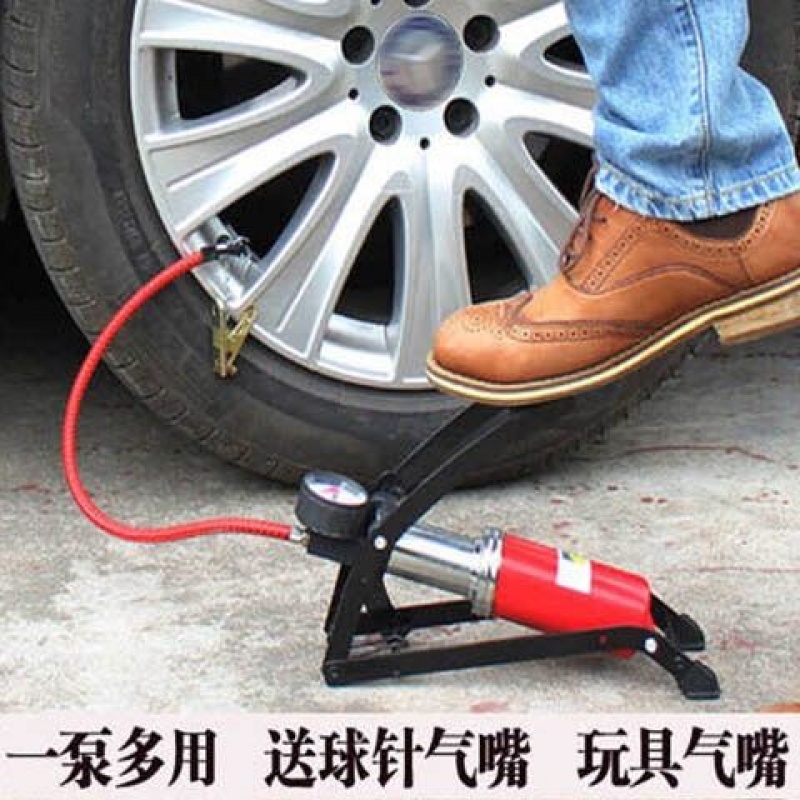
It can be frustrating if you just pumped up your tire and the pressure is already low again. If this is the case, you might have a flat tire that you don’t know about. The quick solution is to patch the hole in your tire.
Depending on the placement, width, and number of holes in your tire, you might have to completely replace it.
Keep in mind that tire pressure will also fluctuate as the seasons change. I recommend frequently checking the pressure of your tires and expect to pump them up in winter when the air gets cold.
After explaining this whole process, you might be curious where the bike pump comes in. Well, there are a few reasons why you might try using a bike pump to inflate your car tire.
If you’re stuck somewhere and your tire desperately needs air, you might have to grab a bike pump. This will give you enough temporary pressure to make it home or get to the nearest gas station to refill there.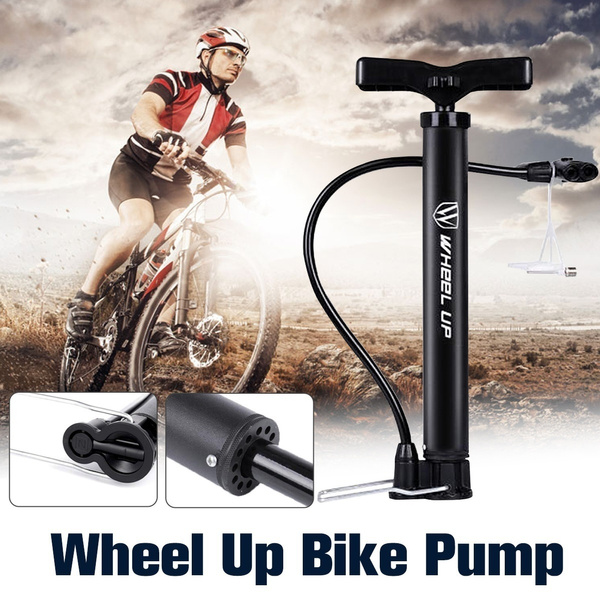
Some people simply don’t have access to a compressor and they need to top off their tire. If you need to get to work or plan on driving to a compressor somewhere else, you might be tempted to grab a bike pump — especially if that’s all you have at your disposal.
I would wager that the most common reason why someone would use a bike pump is that they just patched a flat tire.
After getting a puncture in your tire, there’s a way to seal the gap so you can keep driving. After the seal is done, your tire will still be very low.
At this time, you can grab the bike pump and get to work refilling the tire.
There are other people who are just genuinely curious about this question and might have made a bet about it.
Intuitively, it makes sense. Bike pumps deliver enough air to pump up footballs and basketballs. But, do they have enough power to pump up your tire?
If you made a bet on this topic, you’re about to win or lose it.
This leads us to the million-dollar question: can you use a bike pump to inflate a car tire? The answer is yes. I’ve actually personally done it myself, so I can attest to the fact that it works.
It’s only an option for people with patience though. You can put in hundreds of pumps to re-inflate your car tire.
These pumps are designed to inflate bike tires to upwards of 80 psi, so they definitely have the strength. The key difference is the volume of air, though.
Something that might take two dozen pumps to achieve on a skinny bike tire would take 200 pumps on an automobile tire. You’re going to be pumping that bike pump for a long time (but it’s far from impossible).
I know it might be too late to bring this up, but there’s a great product that will help you to avoid this disaster in the future. It’s a portable air pump for car tires.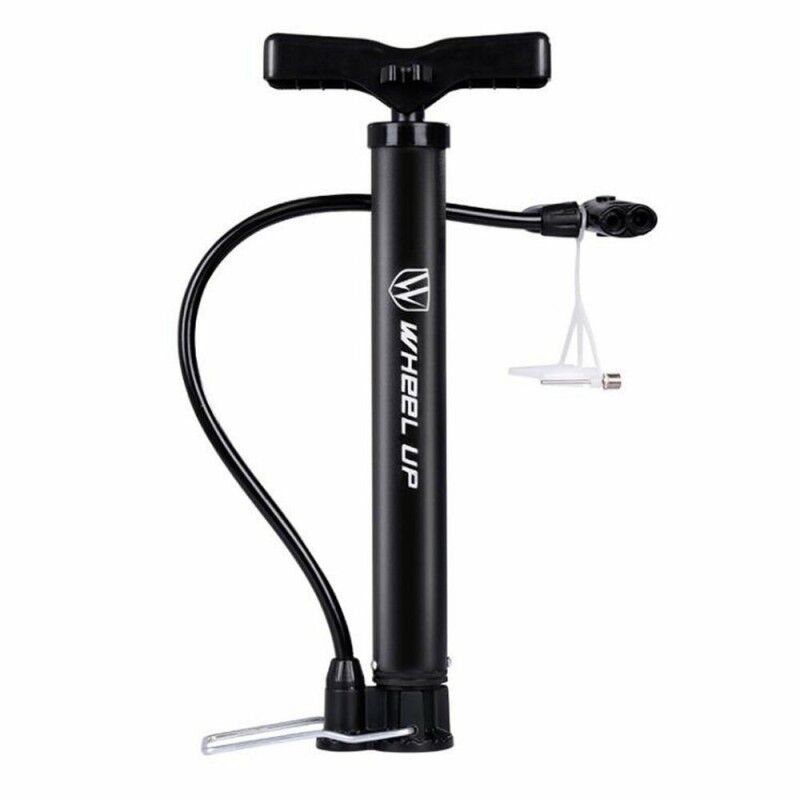
NORSHIRE Tire Pump Inflator Portable Air Compressor
NORSHIRE Tire Pump Inflator Portable Air CompressorI own one personally, and it’s saved me in a few sticky situations. Rather than spending 20 minutes manually inflating a tire, you can just throw this tool on your tire and get the perfect psi within a minute.
If you think you might be in the same situation again in the future, you might as well pick up one of these bad boys today.
In a second, I’ll walk you through exactly how to use that bike pump to inflate your tires. First, let me tell you everything that you’ll need for the process:
Yup, that’s about it.
Without further ado, let me get into my step-by-step guide.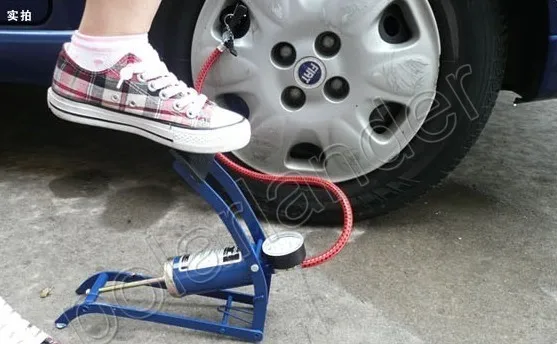 Trust me, this process works because used this exact process not too long ago.
Trust me, this process works because used this exact process not too long ago.
Let’s start by assessing how bad the situation really is. Do you have a nail or screw lodged in your tire? How flat does the tire look? Are you in a scenario where you can safely spend 30 minutes inflating a tire without getting hurt?
Take a look at your flattened tire. Along the center ring, you should notice your valve stem sticking out.
This is the black tube that’s protruding from your tire.
There’s a little cap on the top of this valve stem. You won’t be able to do anything until the cap is removed.
Grab it with your fingers and screw it counterclockwise (remember, lefty loosey). Completely remove the cap and put it somewhere where you won’t lose it, like your pocket.
This is where your tire pressure gauge comes in handy. Push it against the now-exposed valve stem and see how much pressure is in your tire.
You’ll want to look for a “psi” reading — that’s short for “pressure per square inch”. Essentially, it gives a baseline value of how much pressure is in your tire. Quantifying it per square inch allows all different tires to use the same language when talking about their pressure.
Pop open your driver’s door (if it’s safe to do so). On the inside framework, you’ll find a white sticker with some yellow on it. This will tell you how much pressure the manufacturer suggests putting into each tire.
Typically, you’ll find two different values:
If you can’t find this sticker, then Google the psi value for your specific make, model, and year. It should be somewhere around 30 psi.
Now, insert the black valve from the bike pump into the valve stem of your tire. The bike pump’s valve has a little arm on the rear of it.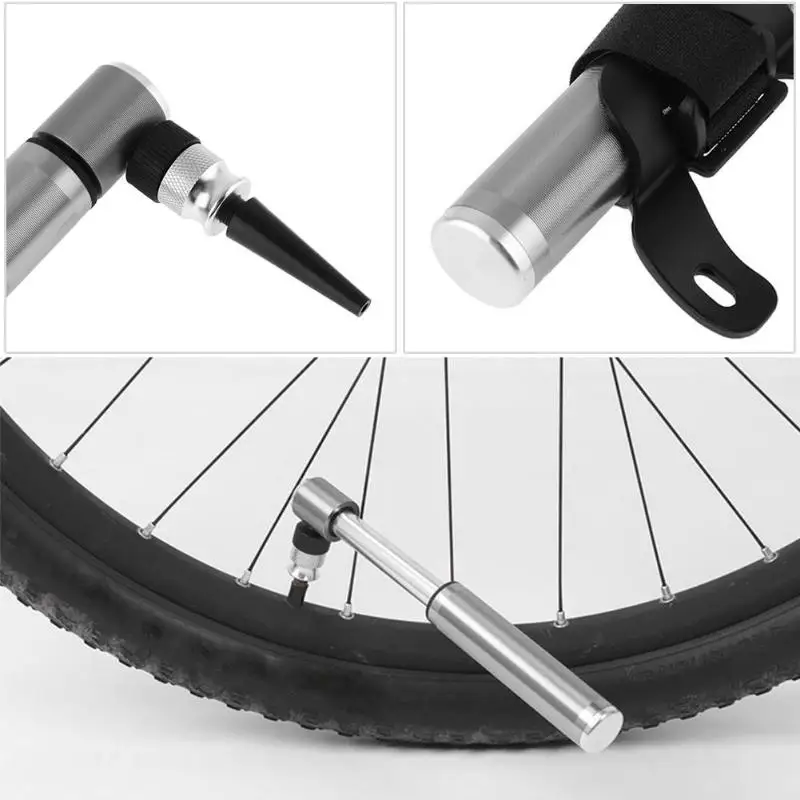
This arm needs to be straight down when you put the valve over your tire’s stem.
To lock the bike pump in, this arm needs to be brought up 90-degrees. When locked, the arm will be perpendicular to the tube feeding the black valve.
Now your bike pump is officially locked in.
This is where the fun starts — it’s time to start pumping your bike pump.
Your bike pump probably has some sort of platform at its base. I like to put my feet on this platform to secure the pump in place.
You’ll use two hands to bring the handle of the pump straight up, then push it straight down. The motion looks like how people would blow up dynamite on TV shows back in the day.
Every time you push the handles of the pump all the way down, you’re pressurizing the inside air of the tire.
After pumping for a little while, you’ll need to check the tire pressure. Do this by unlocking the bike pump valve by swinging that arm down and removing the valve from the tire’s valve stem.
Put your tire pressure gauge on the tire’ valve stem and get a reading. Reset the gauge and take two more readings to ensure the reading is correct.
Keep repeating steps 6 and 7 until you hit a psi value that’s within 5 psi of the recommended value (per the sticker inside your driver’s door).
Why 5 psi? Well, this value will get you close enough so you can drive to a safe location that has an air pump and save you time. Otherwise, you’ll waste even more time manually pumping up your tire.
NOTE: Remember to check whether your bike pump is locked or unlocked every time you put it back on the tire’s valve stem. If you pump when the valve isn’t locked in position, all the air will escape and not go into the tire. You’ll waste your time.
A quick way to check whether it’s locked is to gently pull the valve as if you were going to take it off. If it doesn’t immediately come off, then you’re locked in.
Maybe you’re an overambitious bike pumper and you put too much air in your tires. You might think, “oh, that’s great. Now I won’t have to worry about them getting low for a long time.”
The sad truth is that an overinflated tire is just as dangerous as an underinflated one. The tread won’t properly stick to the road underneath it.
This is where that screwdriver or pebble comes in handy. You’re going to release a little pressure from your tires.
Make sure the cover is removed from your tire’s valve stem and get the bike pump away as well. Use your pebble or screwdriver to gently push against the valve stem of your tire.
Doing so will result in a hissing noise that you can hear. This is air escaping from your tire through that little valve.
Make sure you only do this for a few seconds, maximum. Remove your pebble or tool and grab your tire pressure gauge and check it. If it’s still high, repeat this process again for a few seconds and check once more.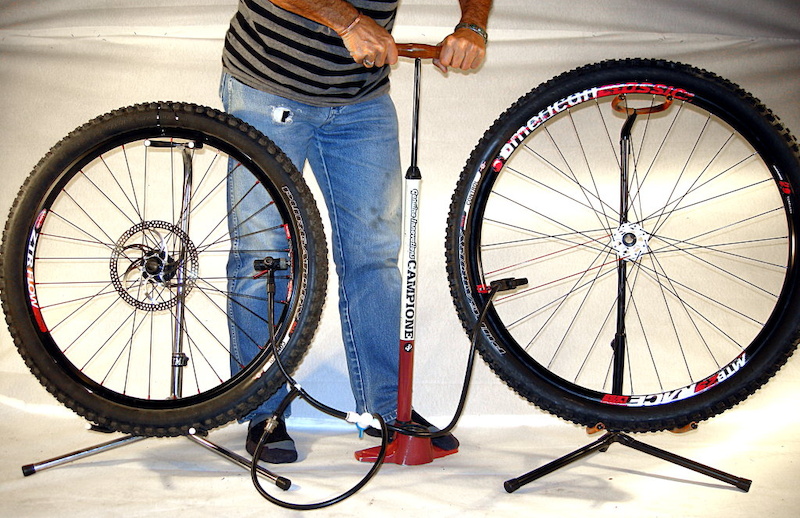
Be careful not to overdo it in the opposite direction and bleed out too much air. It’s a delicate balance.
The good news is that your bike pump is within reach if you happen to release too much air in this step.
I’m glad to deliver some good news to you guys and let you know that bike pumps can actually be used to inflate a car tire. If you want to see answers to more of your car questions, either drop a comment below or read the rest of my blog. I also posted a list of other car products that can save your neck in the future.
Your subscription could not be saved. Please try again.
Welcome to Motor Hills!
The “driveway” leading to my childhood home was a rocky dirt road that was just over two miles long. In order to save time & money, my parents bought us an old ’73 Buick to drive back and forth to the bus stop.
In order to save time & money, my parents bought us an old ’73 Buick to drive back and forth to the bus stop.
It was a beater car. All my siblings and I learned how to drive in it.
As you can imagine, we had to replace a lot of parts during that time. Between busted shocks, broken parts and worn-out tires (it’s just a little too fun to “peel out” when you’re a kid!), we learned how to do quick repairs to get where we needed to go.
While working on my son’s project car last week, we saw that he had a low tire. He asked if he could pump it up and then grabbed the bike pump from the garage.
I had to tell him a story. But first, let me answer the question at hand:
You can pump up most car tires with a bicycle pump. As long as the floor pump has a Schrader valve fitting and can withstand the friction of pumping for several minutes, it can be done. Make sure that the leak is slow, the bead isn’t broken and the car tires aren’t too big.
I’ve pumped up a car tire with a bike pump several times.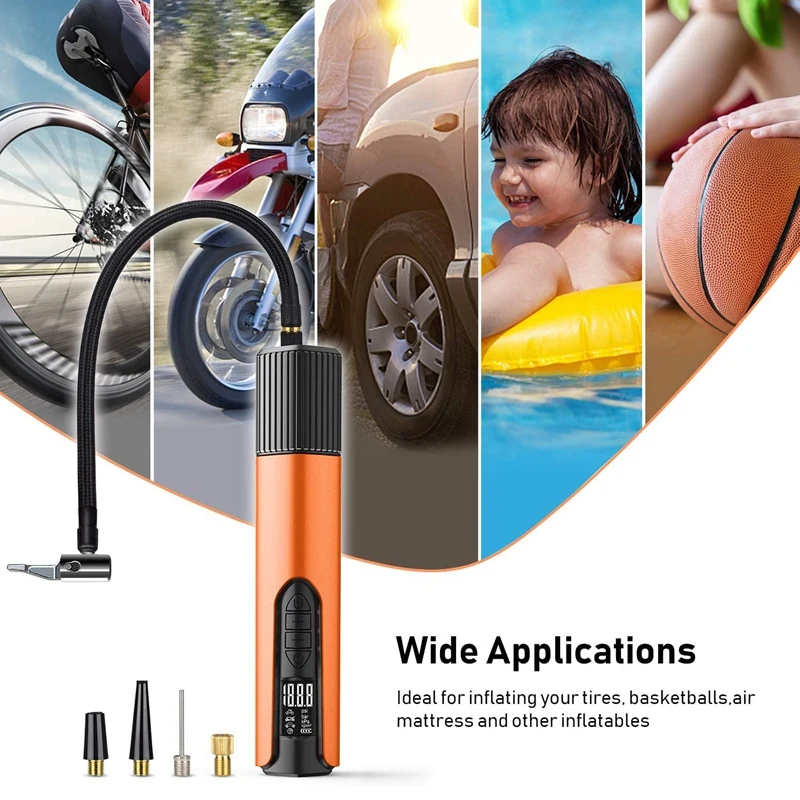 I needed to get somewhere in a hurry only to find that the tire with the slow leak we’d ignored for over a week was now flat.
I needed to get somewhere in a hurry only to find that the tire with the slow leak we’d ignored for over a week was now flat.
We didn’t have an air compressor.
So, thinking I had super mechanic skills, I grabbed our red Schwinn standard bike pump and got to work. It took me around 25 minutes of pumping before I had around 20 psi in the tire.
That was enough to make it to the gas station to get it filled up, and because it was a slow leak, I could ignore it for a few more days until I got it repaired.
It may seem like a silly notion to you, but it can be done in a pinch… but there are a few caveats to dealing with flat tires when all you have is a bike pump.
In short, yes you can inflate an automobile tire with a bike pump. A bike pump is one that sits on the floor, has a plunger that goes up and down, and is normally used to fill bike tires to between 20 and 110 psi. Most of the time they can pump up a bicycle tire in less than a minute.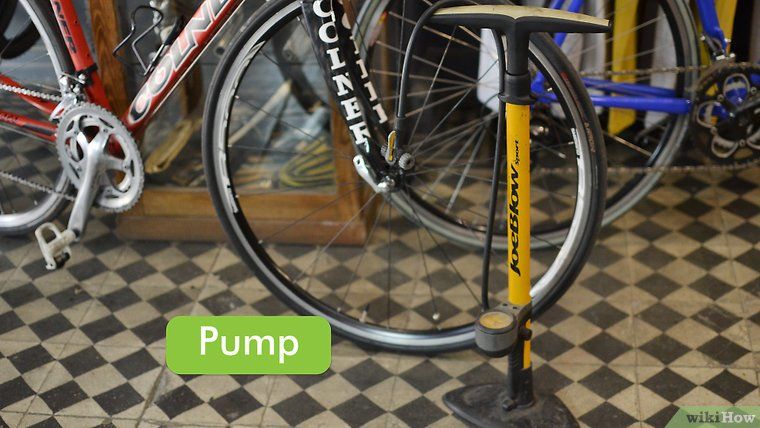
However, there are a few considerations to keep in mind since not just any ol’ bike pump will work for this task. This includes the target pressure of your car’s tires, the type of pump you have, the current tire pressure, and if it’s a slow or fast leak.
If you’re faced with using a bike pump to pump up a car tire, the goal is to fill the tire just enough to get to a tire shop or repair facility – and do it fast enough to justify not just putting the spare on.
You can check for the tire’s target pressure by looking in two places. This should be noted on either the wall of the tire or inside the driver’s door. Important information should be listed in a chart on a sticker on the door. It will give the proper tire pressure for both the rear and front tires.
Pay close attention to the units that are used in this as you don’t want to use the wrong unit of measurement when inflating them. It will either be measured in PSI (pounds per square inch), Bar (imperial) or kPa (kilo Pascals – metric).
You’ll need a specific type of pump for this purpose. There are two common valve types on bikes – Schrader & Presta.
Even if it’s considered to be for bike tires, if the pump has a Schrader receiver on it, this should work just fine. You’ll know it has a Schrader receiver if there’s a little pin in the middle of the opening.
This is pressed onto the tire, and it releases pressure. A pump with this type of receiver is common, so you may have it at home already.
The other type of valve common on bike pumps is the Presta Valve. This type of valve has a threaded pin that can be depressed when unscrewed. You won’t be able to use a Presta pump to fill a car tire as all car tires use Schrader valves – usually with removable cores.
You may also have access to a bike mini pump or a frame pump. Neither of these is a good option as they are barely big enough to use on a bike. You’ll also want to avoid any pump that is specifically designed for a road bike as they’re smaller and don’t produce enough air for most car tires.
Ultimately you want a pump that has a large enough cylinder so an adequate volume of air can be pumped with each stroke. Otherwise, you’ll never get the car tire filled.
You’ll want to know how much pressure the tire is before you try to inflate it with air. The best way to do this is to use a pressure gauge.
Some bicycle pumps have a pressure gauge on them.
You’d put the tire valve into the pressure gauge, apply pressure, then you’ll see it move to give you a reading. If you don’t have a gauge or don’t want to rely on the gauge that’s with the bike pump (which isn’t always accurate) you can fill it with enough air so that the rim isn’t touching the ground and there’s some air filling the sidewall (and tire).
Then, bring it in to a repair shop for assistance.
Is your car’s tire leaking air slowly or quickly? The answer to this determines how likely you’ll achieve success with a bike pump.
If the tire is leaking slowly, this is a good sign that you’ll most likely be able to use a bike pump.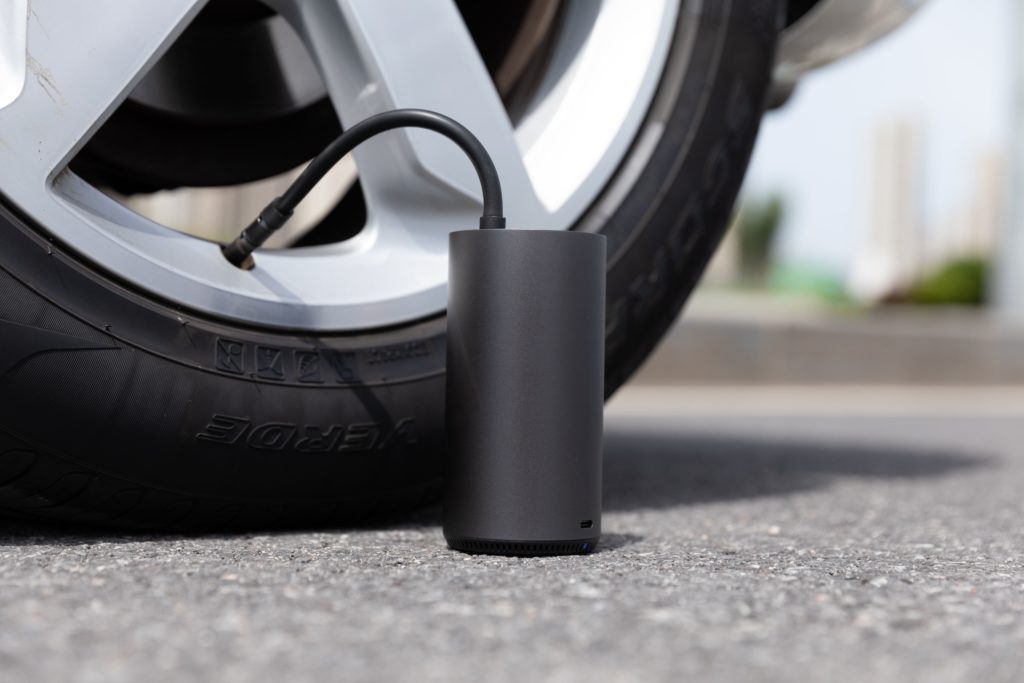
If air is leaking out fast, this can indicate a worse issue and may require you to put the spare tire on the car or bring it to a repair shop for more extensive work.
In most cases, a bike pump won’t be able to keep up with a fast leak. No matter how quickly you pump.
If you need a quick fix when you are leaving for work and find that your tire has low pressure, you might break out your bicycle air pump. It’s ideal for when you have a slow leak and can’t see any other issues with the tire.
The other option would be if your spare tire, jack or lug wrench are missing or broken. In this case, one of your last resorts would be the bike pump.
You also might bring it somewhere for a patch on your way to wherever you have to go.
Remember that over and under-inflation of a tire can damage the tire and rim. This is why it’s necessary to be careful as you’re doing this so that you fill it up as accurately as possible.
Make sure you know which type of adapter plug isn’t compatible with your tires. Some bike pumps have a unique plug design that shouldn’t be used for automobiles.
Portable bicycle pumps (that can hook onto bike frames and you can take it with you wherever you go) aren’t a good option for car tires.
Even if you attempt it, you’ll need to pump hundreds or thousands of times to inflate the tires. Who wants to do that?
It can take a while. Unless you have a high-volume bike pump (like something designed for mountain bikes or fat tire bikes), you’re looking at 15 to 20 minutes in most cases. Maybe longer.
Obviously, it depends on how flat the car tire is, how quickly the air leaks and how fast you can pump.
Just know that you’re probably not going to pump up a car tire with air to its maximum pressure with a bike pump alone.
Now that you know you can pump up a car tire with a bike pump and decide you need the workout, here’s how to do it.
 At this point, check the tire pressure again. If you’re making progress, keep going. If not, you may need to re-assess your approach.
At this point, check the tire pressure again. If you’re making progress, keep going. If not, you may need to re-assess your approach.CO2 tire “pumps” are made for inflating bike tires quickly – they are portable and fast for bikes. They’re usually used during races or when you’re on an intense training ride.
However, these wouldn’t work on car tires. The amount of gas in these types of pumps isn’t sufficient to fill a car tire – even just “enough” to get you back on the road.
They do make emergency CO2 tire inflators for cars. The tank for this type can be refilled and is controlled by a valve and gauge. This means that it’s an excellent choice for filling up your tires with air accurately. Larger versions can be quite expensive, though it’s well worthwhile in terms of saving you time and the headache of having to run to the repair shop.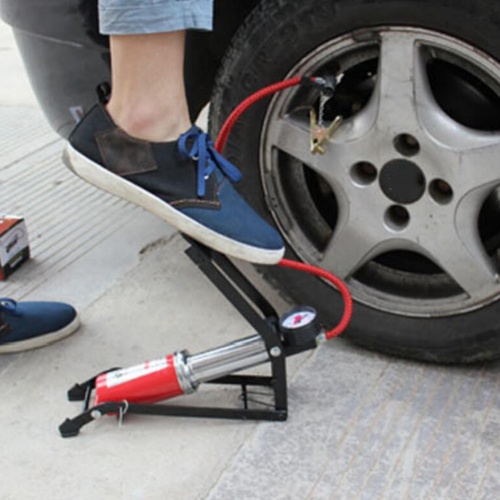
This might be a good time to order one and put it in your car “just in case”.
The whole point of this article was to answer the question of what to do if you find your car’s tire flat and you don’t have a way to pump it up – other than a bike pump. Obviously, you’d want a pump that moves a lot of air quickly.
A floor pump that has a large chamber and a tight seal would work well. A foot-operated floor pump would also be a good option.
If you want a good bike pump, you want one that pushes out a lot of air quickly. Here’s a review of the one we’ve loved for years – Topeak Joe Blow Sport II – but it’s hard to find now. It’s been replaced by the Joe Blow Sport III.
If you made it this far into the article, maybe you’re now convinced that you don’t really want to try and use a bike pump to inflate your car tire. If that’s the case, we have a few more options for you:
Many gas stations have air compressor stations that are either free or a dollar. It used to be that you had to carry change with you so you could use one of these machines. Anymore, if you can find them, they’re usually free.
It used to be that you had to carry change with you so you could use one of these machines. Anymore, if you can find them, they’re usually free.
Otherwise, they usually accept credit cards at the machine.
Then it’s as simple as using it to fill your low tire and then get it repaired.
A lot of tire shops, like Discount Tire or Tire Rack, will check and fill your tires for free. Some, like the Discount Tire near my house, will repair your punctured tire for free – you just have to have enough air in your tire to make it there.
The most well-known tire sealant for cars is Fix-a-Flat (a great deal as it’s sold on Amazon as a Pack of 2 currently) This is a quick way to fill your tire in an emergency and it will often fill/stop small leaks.
You connect the small hose from the canister to your tire valve and fill the tire with the sealant and compressed air. It won’t get you to the correct pressure all the time, but it should get you enough to get you on the way.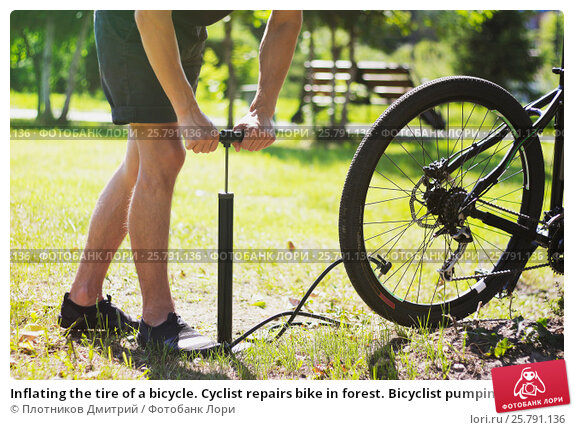
This is a good reminder that you should pick up a couple of cans of this stuff and keep in your car in case of an emergency – for you or someone you come across on the road.
Finally, for around the same price as a couple of cans of Fix-a-Flat, you can buy a portable air compressor. Most of these are designed for cars and will come with a DC adapter plug so you can plug it into your car’s power outlet (what used to be known as the cigarette lighter).
Using portable pumps like this will usually result in getting your tire to the correct air pressure and get you back on the road.
Many of these little compressors come with a digital gauge. This is the current best-selling portable air compressor on Amazon.
If you need to use a bike pump to fill your tire – we wish you luck – and hopefully, you were able to learn something from this article. Even if that was just that you would rather carry a pump or can of inflator with you!
Keep the rubber down.
Contents
Flat tires do not bode well for the cyclist. The situation must be resolved immediately, otherwise you will have to become a pedestrian for a while. What should be done? That's right, pump up the camera and calmly continue moving. Consider how to pump up a bicycle wheel with a pump, what subtleties are available when using an autocompressor, and whether it is possible to do without a pump.
Tire pressure is the main parameter that is responsible for the speed of movement, grip and safety of the cyclist. The average minimum indicator for bicycles is 2 atmospheres. For driving on asphalt, the recommended value is within 3.5 atm., For primers - 2. 6 - 2.8 atm.
6 - 2.8 atm.
It is easy and simple to determine the pressure inside the bicycle tube using a pressure gauge - separate or built into the pump:
Another method: feel around the entire circumference of the tire with your fingers. If the rubber does not flex, then you can ride. It should be noted that this method will only give accurate results for thin slicks on road bikes and tires on city bikes.
Consequences of underinflated tyres:
On the contrary, an excess amount of air in the chambers threatens the following:
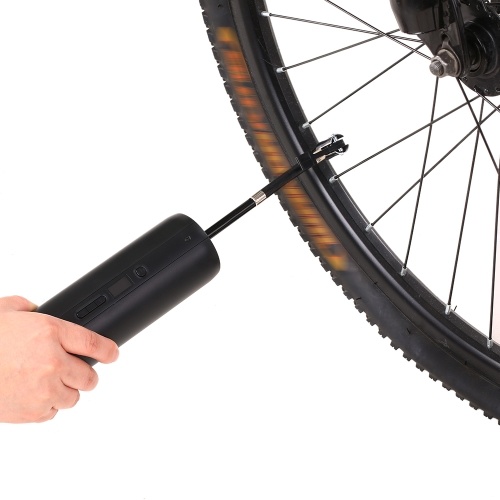
Maintaining the recommended pressure will eliminate all these shortcomings and allow you to get the most out of your trips. Below is a table of values depending on the weight of the cyclist:
| The mass of the cyclist, kg | atmospheres/PSI* |
| 50 | - 2.59/35 - 38 |
| 3.1/45.5 | |
| 90 | 3.6/53 |
| 105 | 3.9/57.5 |
| 4.1/60 | |
| 118 | 3.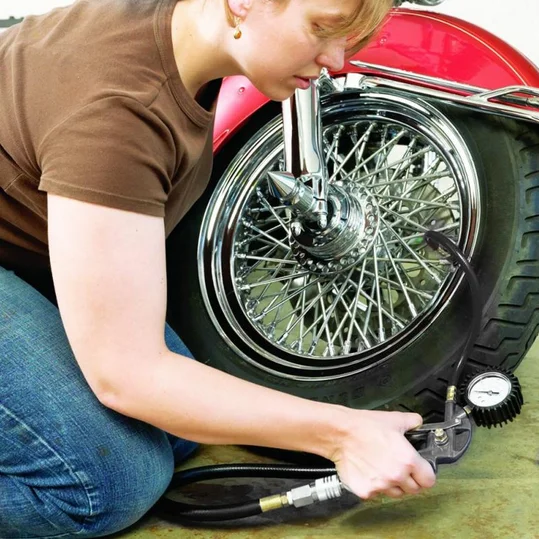 2 - 3.4/47 - 50 2 - 3.4/47 - 50 |
*1 atm = 14.696 Psi
In general, a bicycle pump is a necessary thing for every cyclist. With the help of this simple device, it will be possible to inflate the wheels on your own, and not roll your bike to a service or gas station.
Hand pumps are divided into two types: simple and with a recording device (pressure gauge). It is recommended to purchase the second option, however, if a separate pressure gauge was lying around in the cabinet, you can buy a cheaper pump.
Universal hand pump with dial gauge
For ease of pumping with a conventional hand pump, you can immediately count the number of air inlets until the optimum pressure is reached and then pump exactly like this, even without additional use of a pressure gauge.
How to inflate the chambers correctly:
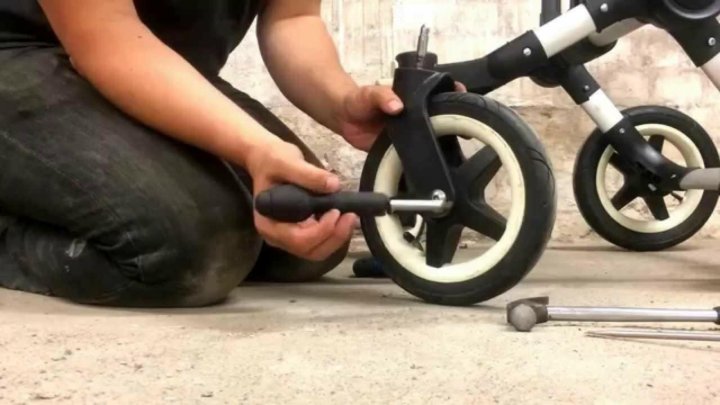 You can also inflate on an upside down bike or the wheel separately if the bike is being dismantled.
You can also inflate on an upside down bike or the wheel separately if the bike is being dismantled. Pressure tracking:
By the way, the latter will not be superfluous to do with a pressure gauge, since the pressure inside the pump can increase during pumping, but air does not enter the chamber (the valve is not completely closed) or exit through a hole in it.
Common bicycle nipples are automotive and Dunlop. For thin wheels, a Presta nipple with a valve is used. It requires cleanliness and accuracy in handling.
Presta tubes fitted to road bikes and select hybrids
A special small volume pump is matched to it. A regular bike pump may not fit or you may need to use an adapter.
A regular bike pump may not fit or you may need to use an adapter.
Most bicycles have a "Schrader" or car valve. The standard option allows you to inflate tires at gas stations and public bike pumps (of which there are only a few in our cities so far) directly.
How to inflate simple wheels with a car pump:
How to inflate your Presta with a compressor at a gas station:

In this case, it is very important to know exactly how many atmospheres it is necessary to let air into the chambers. With increasing pressure, it can quickly burst.
The last option left is Dunlop. It is identical in size to an automobile nipple, but in terms of design features it is similar to the French one (aka Presta). When inflating a wheel, you should follow the rules for a sports analogue.
Is it possible to inflate bicycle inner tubes without a pump? It is unlikely to reach the recommended pressure, since a regular supply of pressurized air is required, but you can reach the minimum values. Let's consider several methods of pumping chambers, which can be resorted to without using a pump:
Vacuum cleaner. Many models are equipped with a blower mode, when switched to which air is blown out. A thin hose can be used to connect the wheel nipple. The result directly depends on the tightness of the connection between the hose and the nipple. Here you can use rubber pads, clamps and even rags.
A thin hose can be used to connect the wheel nipple. The result directly depends on the tightness of the connection between the hose and the nipple. Here you can use rubber pads, clamps and even rags.
Bottle pump. You will need two plastic bottles. One of them will serve as a cylinder, the other as a rod. Cut off the bottom of the first bottle and connect its neck through a thin hose to the chamber outlet. Next, insert the second bottle into it and with translational movements pump air through the cylinder into the hose. For tightness, grease the connection of the neck and the hose with sealant or lay a rubber pad. High pressure cannot be created, but it is possible to ride the N-th distance on a bicycle.
Schematic illustration of a bottle pump: 1 - stem, 2 - cylinder, 3 - cylinder neck, 4 - hose
The third way is to remove the nipple and inflate like a balloon. The method is fraught with difficulties in its removal and installation in its rightful place.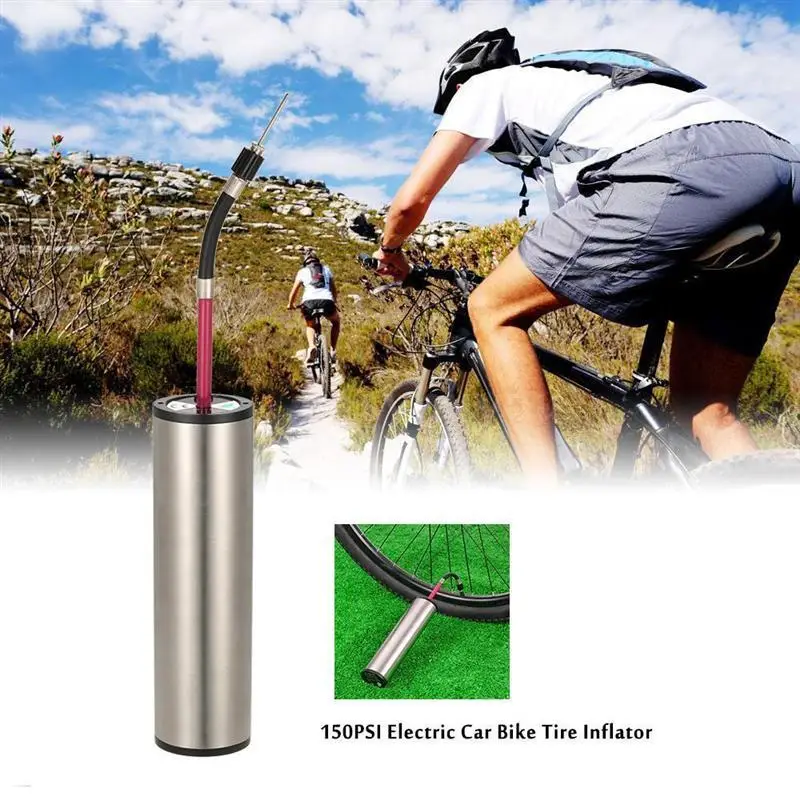 It will be especially difficult to install back, since during this time all the air can be released.
It will be especially difficult to install back, since during this time all the air can be released.
An alternative tire inflation option is to inflate with a bicycle air fork pump. You will have to work hard, as this pump is designed for small volumes.
Despite the fact that a resourceful person will find a way out of any situation, it is recommended to have a special pump for tire inflation. Moderately inflated bicycle chambers are the key to comfortable trips without unpleasant surprises in the form of a burst chamber or damage to the wheels.
CONTENT OF THE ARTICLE:
No special effort is required to properly inflate bicycle tires. The only thing you need is the right tools. Using these techniques, you can easily find your valve type and choose the pump that is exactly right for your bike model, respectively, and learn how to properly inflate your tires.
The only thing you need is the right tools. Using these techniques, you can easily find your valve type and choose the pump that is exactly right for your bike model, respectively, and learn how to properly inflate your tires.
Related: How to choose a bicycle pump?
1. Schrader valve, sometimes you can see the name American valve or automobile valve. The stem in this type of valve is surrounded by threads, you just need to press down on the stem with your thumbnail or other object, such as a pen cap. If we compare Schrader valves with other types, then it is short and wide in diameter. Most often they can be found on cars, inexpensive or mountain bikes. To open this type of valve, you just need to unscrew the rubber plug.
2. Determine the recommended tire pressure for your bike. Often this indicator is located on the sidewall of the tire. Be vigilant and watch the pressure when you inflate your tires. It is recommended not to bring the readings to the lower line, as well as to the highest.
It is recommended not to bring the readings to the lower line, as well as to the highest.
3. Position the pump. If you don't already have your own, use the pump at the gas station, or borrow one from a friend.
4. Pump up the chamber. To do this, unscrew the rubber cap on the top of the valve and hide somewhere so as not to lose it.
5. To deflate a tire with a Schrader valve, simply press the springy valve stem with your fingernail or other small object until all air is expelled.
1. French valve (Presta) or else you may see the name Sclaverand is commonly found on high performance road bikes. Compared to a Schrader valve, this one is longer and narrower in diameter, and has an outer stem that is capped instead of being surrounded by a core.
French valve (Presta) or else you may see the name Sclaverand is commonly found on high performance road bikes. Compared to a Schrader valve, this one is longer and narrower in diameter, and has an outer stem that is capped instead of being surrounded by a core.
2. Valve opening. Unscrew the dust cap to open the Presta valve. Then you need to loosen the brass cap on the valve stem a little, it will not be able to come out completely, and you will have to lift it up a little. If you want to check if the cap is loose, you just need to press on the valve stem, and if you hear that the air comes out in sharp gusts, then this is a sign that you can stop.
3. Calculate the recommended tire pressure for the bike. This is usually a relief mark that is located on the sidewall of the tire. Most often, these readings are written in bars or PSI. Do not let the pressure go to the bottom line, and also to the highest, which exceeds the maximum.
4. Pump installation. You can use the pumps of any gas station stations or take them from friends. And as an option - buy in the store "everything for bicycles".
5. Inflate tires. Open the Presta valve by unscrewing the dust cap and loosening the smaller brass cap.
6. To deflate a tire with a Presta valve, open the brass cap and press the springy valve stem until all air is expelled.
The third type of valve is the English Woods valve, or the name Dunlo is also found.